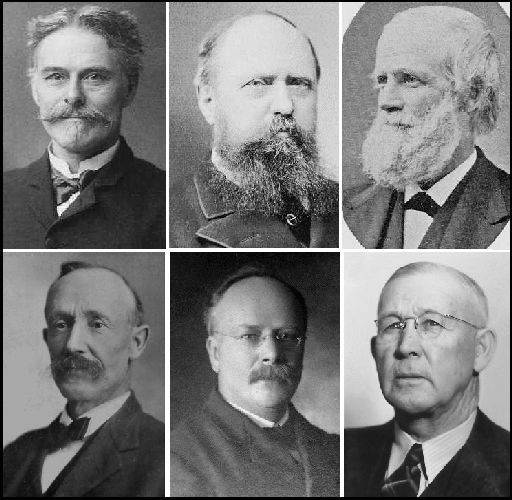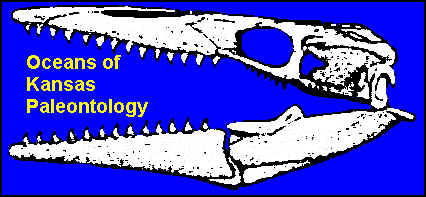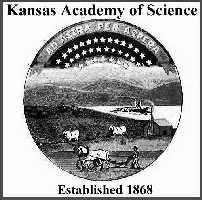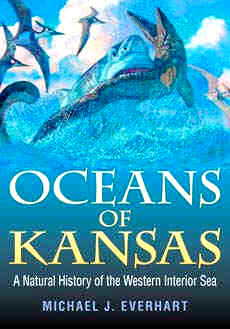| Beckemeyer, R. J., Research Associate, Natural
History Museum Entomology Division (Paleoentomology), University of Kansas. THE EARLY PERMIAN INSECT FAMILY LEMMATOPHORIDAE
SELLARDS, 1909 (SENSU STOROZHENKO, 1997).
Species of the Polyneoptera family Lemmatophoridae Sellards, 1909 are a diverse and
abundant component of the Wellington Formation of Kansas; four of the six species of
insects from the Elmo, Kansas deposits with over 100 specimens each are lemmatophorids. Lemmatophoridae have also been documented from
Early Permian localities in Germany (Hornschmeyer, 1998) and Russia (Zalessky, 1952;
Novokshonov, 2000; Aristov, 2001, 2004; Aristo et al., 2006). The systematic paleontology and biogeography of the
family is briefly reviewed and the distribution of Wellington Formation species in Kansas
and Oklahoma is reported. Of eight species of
Lemmatophoridae known for the Wellington Formation, five are common to Kansas and Oklahoma
and three are unique to Kansas.
DePalma, R. A.(2), Department of Paleontology, University of Kansas. A PRELIMINARY STUDY OF THE USE OF CYANOBACTERIA IN
A NOVEL APPROACH TO FOSSIL PREPARATION. The field of fossil preparation has changed little
in the last hundred years. While slight advancements have been made in the stabilizing
polymers and hand tools, the process by which matrix is removed from delicate fossils has
remained virtually unchanged. In this study the cyanobacterium Hyella sp., a known contributor to the biological
weathering of rocks, and the gastropod Neritina
reclivata are tested in a possible new technique to remove carbonate matrix from very
delicate fossil specimens. The effect of cyanobacterial degradation of rocks is well
known, however the use of cyanobacteria to enhance the preparation of fossil specimens is
a new and unexplored field of paleontology. In this study, the combined effects of
microscopic and macroscopic organisms on fossil bone-containing rock samples were
examined. The coupling of macroorganisms with microorganisms produced greater
matrix-removing results than either accomplished individually and damage to fossil bone
samples was not observed.
Everhart, M. J. Sternberg Museum of Natural History, Fort Hays State
University. NOTE ON A PLESIOSAUR SPECIMEN FROM THE KIOWA SHALE (EARLY CRETACEOUS; MIDDLE
ALBIAN) OF KIOWA COUNTY, KANSAS. The well-preserved, nearly complete left ischium of a
small plesiosaur was collected by the author from the basal Kiowa Shale near Belvidere,
Kansas in August, 2008. It occurred approximately 0.5 m below the first major bentonite in
the lower Kiowa Shale (Early Cretaceous; Upper Albian; Venezoliceras kiowanum
Zone), and about 4 m above the basal Champion Shell Bed. The specimen (FHSM VP-17302)
represents a plesiosaur that was 3-4 m in length. Another ischium (FHSM VP-2984) is
similar in size but appears to represent a different taxon. Plesiosaur remains are the
most common of any of the marine tetrapods from the Kiowa Shale and have been collected
from Kiowa and Clark counties since the 1890s. More recently their remains also have been
discovered in McPherson County. While the remains of these early plesiosaurs are
well-represented in the collections of the University of Kansas Museum of Natural History
(KUVP) and the Sternberg Museum of Natural History (FHSM), few of the specimens are
reported in the literature. The type specimen of Plesiosaurus mudgei(KUVP 1305),
including limb bones, vertebrae and gastroliths, is figured in a 1903 photograph by
Williston. Further study of these historically collected specimens is hampered by the lack
of associated stratigraphic information. The collection of future specimens with accurate
field data is important to our understanding of the occurrence of marine vertebrates from
the Early Cretaceous in Kansas.
Everhart, M.J. and G. Pearson, Sternberg Museum of Natural History,
Fort Hays State University. FIRST REPORT ON A
MARINE TURTLE FROM THE FAIRPORT CHALK MEMBER OF THE CARLILE SHALE OF MITCHELL COUNTY,
KANSAS. The type specimen of the giant protostegid turtle, Protostega gigas, was collected by E.D. Cope from
the Niobrara Chalk in 1871. Since that time, numerous specimens of this and other turtle
species have been collected from western Kansas. Although turtle remains are known from as
far back as the Early Cretaceous (Kiowa Shale) in Kansas, specimens other than those from
the Niobrara are generally rare and usually fragmentary. The type specimen of another
protostegid turtle, Desmatochelys lowii (KUVP
1200), was collected from the older Fairport Chalk (Late Cretaceous; Middle Turonian) near
Fairbury in south central Nebraska in 1893, but in general the remains of turtles are rare
and fragmentary in the entire Carlile Shale Formation. In September, 2008, the authors
collected the anterior skeleton of a large marine turtle in situ from a roadside exposure of the Fairport
Chalk in Mitchell County, Kansas. The remains consist of a complete skull and mandible,
cervical vertebrae, a complete left front limb, elements of the right front limb, and
anterior portions of the carapace, including the nuchal. The missing portion of the
skeleton suggests that the turtle was bitten by a larger predator, possibly the pliosaur Brachauchenius lucasi. So far as can be determined,
this specimen includes the first turtle skull collected from the Fairport Chalk in Kansas.
While the specimen has been provisionally identified as Desmatochelys, there are some differences noted
between the humeri of the type as figured by Williston (1894) and the new specimen.
Falk, A. R.1 (2) and L. D. Martin,2 1Department of Geology, University of
Kansas, and 2Museum of Natural History, University of Kansas. DETERMINING MESOZOIC BIRD TRACKS WITH BEHAVIORAL
CRITERIA The first discoveries of North American Mesozoic tridactyl tracks were named Ornithichnites
and were hypothesized to have been made by large birds (Hitchcock, 1836). These tracks are
from the Lower Jurassic and are now considered to have no known tracemaker (Rainforth, 2002). One of the criteria for
distinguishing bird tracks from dinosaur tracks is the presence of a reflexed hallux
(Lockley et al., 1992). Other criteria used to identify bird tracks include the
length:width ratio (Currie, 1981), claws II and IV curving away from the midline of the
foot, and the angle of divarication between toes II and IV (110-120o in birds)
(Lockley et al., 1992). These morphologic criteria are satisfactory for many Mesozoic
trackways. In ambiguous cases, behavioral aspects of modern shorebirds may assist in
distinguishing bird trackways from dinosaur trackways. Theropod dinosaurs leave straighter
trackways going directly from one place to the other, whereas birds usually leave a more
sinuous trackway where the vector of overall movement may be difficult to determine. An
individual bird will often overstep its own tracks while this is rare or absent in
theropod dinosaurs. Evidence of flight such as takeoff or landing traces provides
confirmation of an avian origin. Foraging traces such as probe, scrape or dabble marks may
also show characteristic avian behavior. Using behavioral interpretations, trackways such
as Trisauropodiscus and other questionable
Jurassic tracksites may be revisited and potentially re-interpreted.
Hamm, S. A. THE
OCCURRENCE OF PTYCHODUS RUGOSUS (PTYCHODONTIDAE)
IN THE WESTERN INTERIOR SEAWAY AND GULF COAST. Tooth specimens previously ascribed to the Late
Cretaceous shark Ptychodus anonymus Williston
(1900) from the Smoky Hill Chalk Member of the Niobrara Chalk are re-diagnosed as Ptychodus rugosus Dixon (1850) based on
comparisons with the type specimen from the English Chalk.
Ptychodus rugosus differs greatly
in morphology from P. anonymus in regards to
tooth size, occlusal ornamentation and stratigraphic occurrence. Although it is a rare taxon in North America, being
present only in Late Coniacian deposits in Kansas and Santonian deposits in Alabama and
Texas; most specimens are represented by relatively complete tooth sets from varying
ontogenetic stages. Morphometric data obtained
from these tooth sets provides information regarding the changes in dental morphology
through ontogeny. Post cranial skeletal
elements consisting of dermal denticles and calcified vertebral centra are associated with
a juvenile and an adult specimen of P. rugosus
and offer clues to the body form this taxon possessed.
Hoffman, B. L., C. E. Hoffman, and S. A. Hageman, Department of
Natural and Physical Sciences, Park University. MICROICHTHYOLITHS
AND CONODONTS FROM THE QUINDARO SHALE AND ARGENTINE LIMESTONE OF THE KANSAS CITY GROUP.
The Quindaro Shale (15 cm thickness) and Argentine Limestone (5.5 m thickness) Members
(Wyandotte Limestone, Kansas City Group, Upper Pennsylvanian System) are marine regressive
sediments prominently exposed at Park University, Parkville, Platte County, Missouri. Microremains from this locality were separated from
Quindaro Shale soaked in water or from Argentine Limestone treated with 10% acetic acid.
The sediments were then examined with a dissecting microscope and 3128 specimens isolated. Remains from several groups of fishes are evident,
including chondrichthyans (sharks and acanthoid fishes), bony fishes and craniates
(conodonts). “Teeth” from Gunnellodus belistriatus, Gunnellodus cameratus and Gunnellodus trispinosus, which resemble cephalic
and branchial denticles from stethacanthid sharks are found throughout the two members and
represent 11% of identified fish remains. “Teeth”
similar to Zangerlodus williamsi (1%) and
cladodont-style teeth (1%) are also found. Listracanthus denticle fragments account for
another 1% of fish remains. Other shark
remains include placoid scales (17%) previously referred to several form genera (Cooleyella, Cooperella, Fortscottella, Hammondella,
Kirkella, Moreyella, and Williamsella).
Scales and fin spines from acanthodian fishes are commonplace (20%). Isolated teeth, teeth in jaw fragments and scales
of bony fishes are also numerous (15%). Present,
but rare, are teeth from petalodonts and tooth plates similar to lungfish. Conodonts are common (34%), including Idioprioniodus and Streptognathodus from the Quindaro and Streptognathodus, Idiognathodus, Hindeodus, and Adetognathus from the Argentine. The conodont distribution also indicates a
transition from open ocean to shallow nearshore paleoenvironments. This marine regression is likewise evident from
examination of associated invertebrate fossils.
Martin, L. D. and T. J. Meehan, Museum of Natural History and
Department of Ecology and Evolutionary Biology, University of Kansas, and Chatham College,
Pittsburgh, PA.
AN ASTRONOMICAL STRATIGRAPHY. A recent paper by van Dam and others
extends the stratigraphic use of the Milankovitch orbital variations to include a 2.4
million year climatic cycle or roughly the duration of a marine zone. Previously the Milankovitch cycles provided an
explanation for the hundred thousand year fluctuations seen in ice ages. Van der Hammen in the 1950s recognized a
climatically induced cyclicity in the fossil record with individual units having about the
duration of a marine zone and these units grouped into bundles of three repeating cycles
near the average duration of a marine stage. A
similar pattern was recognized by Martin in 1985 using North American Land Mammal Ages. Van der Hammen concluded that these cycles were the
ultimate basis of global biostratigraphy and Martin and Meehan in 2005 concluded that they
influenced the patterns of evolution found in the fossil record. Melott has recently supported a larger cycle of
around sixty-two million years a scale close to the average for a geological period. We thus have potential astronomical explanations
for most biostratigraphic patterns and wonder if it would make sense to base time
stratigraphic units on the astronomical scales forming a kind of calendar for earth
history. Because of the repetitive nature of
the astronomical controls, some aspects of climate change and evolution might be
predictable.
Melott, A. L., Department of Physics and Astronomy, University of
Kansas. A STRONG, 62 MYR BIODIVERSITY CYCLE COMMON TO THE
SEPKOSKI AND PALEOBIOLOGY DATABASES. After decades of tantalizing partial results,
the existence of periodicity in fossil biodiversity has finally been put on a firm
statistical basis: there is a significant 62 Myr cycle in fossil biodiversity. I present a
new analysis of the Paleobiology Database, which agrees with a previous detection by
others in the Sepkoski Database. This cycle agrees in both period and phase with the
oscillation of the Sun normal to the Galactic disk, in the sense that biodiversity minima
coincide with excursions to Galactic north. I
suggest an effect based on the generation of cosmic rays at shock waves due to large-scale
motions in the Local Supercluster of galaxies. I discuss the evidence for these
periodicities and possible mechanisms to affect biodiversity.
Mickle, K. E. (3), Department of Ecology and Evolutionary Biology,
Natural History Museum and Biodiversity Research Center, The University of Kansas. THE LOWER ACTINOPTERYGIAN FAUNA OF THE MANNING
CANYON SHALE FORMATION (UPPER MISSISSIPPIAN, LOWER PENNSYLVANIAN) OF UTAH. The Manning
Canyon Shale Formation of Central Utah (Upper Mississippian-Lower Pennsylvanian) is well
known for its diverse Carboniferous flora but not its vertebrate fauna. The previously described vertebrates from the
Manning Canyon Shale Formation are an acanthodian and two microsaurs. Lower actinopterygian scales and isolated bones
have been mentioned in the literature, but until now, articulated actinopterygians have
not been officially described. Here, the
actinopterygian ichthyofauna of the Manning Canyon Shale Formation will be described for
the first time. Three new species of lower
actinopterygian fishes are described. The new
fishes consist of two new species of palaeoniscoid fishes as well as a new species from
the order Aeduelliformes. It is important to
note that this is only the second occurrence of an aeduellid fish in North America and
that this discovery supports current biogeographical and paleoecological findings of a
marine connection between North America and Europe. It
is also important to note that though there have not been many specimens of
actinopterygians collected from the Manning Canyon Shale Formation—there are less
than a dozen specimens available for study; those that have been collected have been found
to be very different from each other and have uncovered a previously unknown diversity.
Nabavizadeh, A.(1), Department of Ecology and Evolutionary Biology
and University of Kansas Museum of Natural History (BRC), University of Kansas. A POSSIBLE KEY TO THE SUCCESS OF ORNITHISCHIAN
DINOSAURS. The predentary bone is a diagnostic feature of ornithischian dinosaurs. It is
connected anteriorly to the paired dentary bones of the mandible and casts of the original
soft tissue show that a keratinous bill resembling that of modern turtle’s covered
it. It has been proposed that this bill assisted in nipping off vegetation, acting like
the incisors of herbivorous mammals. It seems likely, however, that the predentary bone
acted as an axial point permitting the two dentaries to independently shear vegetation
laterally. Studies have suggested Heterodontosaurus
used a similar mechanism (Weishampel, 1984; Crompton, 1986). Hadrosaurs have a distinct
curvature on the anterior region of the dentaries that suggests a rotating surface at the
dentary-predentary junction and a kinesis similar to that of Heterodontosaurus. The posterior region of the
mandible (including the articular) has an upturned concavity articulating with the
ball-shaped ventral surface of the quadrate bone. In ceratopsians, there is also a similar
junction, but unlike hadrosaurs where the dentary appears to have been able to roll, the
ceratopsian predentary is concave with the flat expansion of the dentary lying against it
so the dentaries could pivot almost vertically. These movements provide a variety of
shears that may serve a similar function but are unlike the masticatory movement seen in
mammalian jaws.
Rothschild, B. M., Biodiversity Research Institute, University of
Kansas. STRESS FRACTURES IN CERATOPSIA: NOT
JUST FOR PEDIOPHILES. Stress fractures, which
commonly afflict ceratopsian phalanges, have been attributed to migration activities,
similar to the march fractures found in athletic and military recruits subjected to
unaccustomed physical stresses. Recent
evidence suggests an additional location, with a different implication. Linear patterns of periosteal reaction were present
on the external surfaces of jugal, squamosal and parietal elements of Triceratops and Centrosaurus.
Erroneously attributed to acute trauma in the past, this pathology actually
represents stress fractures. The en face macroscopic appearance and the standard
x-ray appearance of this linear periosteal reaction are diagnostic for stress fractures. Occasional presence of a linear surface cleft
further substantiates that perspective. Absence of peri-lesional disorganized bone
reaction rules out infectious disease, the only major differential diagnostic
consideration. Stress fractures result from
repetitive stresses, not a single traumatic event. These
stresses individually cause minor disruption of bone structure. If the rate of repair does not keep pace with the
rate of disruption, stress fractures result. Minor
bone structure disruption is also part of the normal growth process. Much of bone reshaping seems to represent a process
of stress (e.g., muscle)-induced plastic deformation.
When that plastic deformation proceeds faster than the repair, stress
fractures occur. It is hypothesized that the
observed linear reaction in ceratopsian skull elements may simply represent part (although
exaggerated) of normal growth or at least that the process of repair could not keep up
with the stress-induced changes of remodeling. This
is parsimonious with the variation in general frill morphology that characterizes
ceratopsian ontology.
Shimada, K.1,2,3, and M. J. Everhart3*. 1Environmental
Science Program, DePaul University, 2Department of Biological Sciences, DePaul
University, 3Sternberg Museum of Natural History, Forth Hays State University. THE FIRST RECORD OF THE LATE CRETACEOUS PYCNODONT
FISH, ANOMOEODUS BARBERI, FROM THE NIOBRARA
CHALK OF WESTERN KANSAS. We describe the first
occurrence of the Late Cretaceous pycnodont fish, Anomoeodus barberi Hussakof, from
the Niobrara Chalk in western Logan County, Kansas. The specimen is an incomplete right
prearticular tooth plate that was surface collected from the upper Smoky Hill Chalk (Lower
Campanian), and represents the second and the youngest occurrence of this species from
Kansas. The addition of A. barberi to the fauna of the Smoky Hill Chalk increases
the total number of pycnodont taxa to four, bony fish taxa to 56, and total fish taxa to
72.
Spears, S. Z. (2), Department of Geology, University of Kansas, A. R.
C. Milner, St. George Dinosaur Discovery Site at Johnson Farm, St. George, UT, D. Ferris-Rowley, Bureau of Land Management, St.
George Field Office, St. George, UT. ESTABLISHING
THE NATION’S FIRST PALEONTOLOGICAL SITE STEWARDSHIP PROGRAM IN WASHINGTON COUNTY,
UTAH. With the increase of fossil theft from
state- and federally-administered lands, protection of the nation’s paleontological
resources has become a prime concern among many groups and organizations. Washington
County, Utah, in particular, has become a “hotbed” of illegal collecting due to
the recent discovery of a large dinosaur tracksite in the area in 2000. To combat this
dilemma, the Bureau of Land Management (BLM) teamed up with the St. George Dinosaur
Discovery Site at Johnson Farm (SGDS) and the Utah Friends of Paleontology (UFOP) to
establish a site-monitoring program. Paleontologists
conduct field surveys and record paleontological sites. Once evaluated, a paleontological
locality is ranked based on site sensitivity and importance, and then placed into a
database of sites being monitored by the site stewardship program. All valuable
information, including UTM coordinates, maps, geology, and fossils, is then compiled into
a site packet, which is given to a trained BLM volunteer.
These trained volunteers monitor sites regularly, looking for any signs of
theft, vandalism, and natural erosion. Any
significant changes are immediately reported to a BLM Law Enforcement Ranger or the SGDS
paleontologist. In 2007, site stewards donated
nearly 1500 hours of site-monitoring time to the program.
Many federal land-managing agencies, who already host volunteer
archeological site stewardship programs, can easily incorporate at-risk paleontological
localities into their existing programs, thus providing protection to valuable and
threatened resources.
Sundell, C., Santayana Institute.
TEACHING EARTH SCIENCE WITH FOSSILS: AN
INTERACTIVE APPROACH. Earth and related physical sciences can be better taught and made
more interesting by using real fossil specimens in K-12 school systems. In Sept 2001 a Triceratops skull and 50% skeleton
was donated to the Olathe school district (USD 233). Over 3200 8th grade Earth
Science students and several hundred high schools students have since been involved in
hands-on preparation of the specimen for permanent interpretation, mounting and public
display. Students have learned a basic
knowledge of stratigraphy, preparation techniques as well as terrestrial paleoecology of
the late Cretaceous of the Western US. Subsequent
to this work student test score in basic science and math improved, presumably due in part
to efforts of Earth science educators coupled
with a volunteer paleontologist. Students at
the high school level also have an opportunity to interpret the process and specimen
during visits of current k-9 students to the project and the display site at the Olathe
North Geoscience Center. We hope to establish a series of science clubs under the
umbrella of what we call the Smilodon Society
open to students and adults in ALL school districts to facilitate extracurricular interest
in the Earth and related Physical sciences by students and their parents.
Thomas, B. C.1 and A. L. Melott2, 1Department
of Physics and Astronomy, Washburn University, and 2University of Kansas. Late
Ordovician geographic patterns of extinction compared with simulations of astrophysical
ionizing radiation damage. Based on the intensity and rates of various kinds of
ionizing radiation events such as supernovae and gamma-ray bursts, it is likely that the
Earth has been subjected to one or more events of potential mass extinction level
intensity during the Phanerozoic. These induce
changes in atmospheric chemistry so that the level of Solar ultraviolet-B radiation
reaching the surface and near-surface waters may be approximately doubled for up to one
decade. Certain regularities in the latitudinal distribution of damage are apparent in
computational simulations of the atmospheric changes.
We previously proposed that the late Ordovician extinction is a plausible
candidate for a contribution from an ionizing radiation event, based on environmental
selectivity in trilobites. In order to test a
null hypothesis based on this proposal, we confront latitudinal differential extinction
rates predicted from the simulations with data from a published analysis of latitudinal
gradients in the Ordovician extinction. We find that the pattern of damage predicted from
our simulations is consistent with the data assuming a burst approximately over the South
Pole, and no further north than -75°. We predict that any land mass (such as parts of
north China, Laurentia, and New Guinea) which then lay north of the equator should be a
refugium from the UVB effects, and show a different pattern of extinction in the
“first strike” of the end-Ordovician extinction, if it were induced by such a
radiation event. More information on
extinction strength versus latitude will help test this hypothesis.
Thomasson, J. R., Department of Biological Sciences, Fort Hays State
University. EVIDENCE OF SEED PREDATION ON ANTHOECIA OF BERRIOCHLOA TUBERCULATA (POACEAE) FROM MIOCENE
OGALLALA SEDIMENTS IN SCOTT COUNTY, KANSAS. My
studies at an Ogallala Formation site in Scott County, Kansas have revealed the presence
of an abundant Miocene flora that includes reproductive structures of grasses (Poaceae,
anthoecia), sedges (Cyperaceae, achenes), borages (Boraginaceae, nutlets), and hackberries
(Ulmaceae, endocarps). Grasses are especially
abundant and include at least six species from the tribes Stipeae (Berriochloa and Nassella) and Paniceae (Panicum). Fossils
were recovered dispersed in sediments or collected as dense aggregations located in
tubular to lenticular structures that probably represent burrows of small mammals or
arthropods (e.g., harvester ants such as Camponotus
or Pogonomyrmex) similar to those I previously
described from western Nebraska. Among the
grass fossils are anthoecia of Berriochloa
tuberculata that show evidence of predation in the form of small, generally circular,
holes at the base of lemmas that are interpreted as exit structures. This type of damage is rare in the Cenozoic fossil
record and has not been previously been reported on fossils from the widespread Ogallala
Formation. Although the seed predator
responsible for the holes is unknown, similar damage is formed on floral bracts of the
living bromeliad Werauchia gladioliflora by
adult phytophagous wasps of Eurytoma weraudia as
they emerge from flower buds. |






